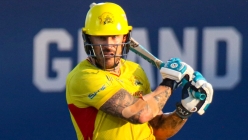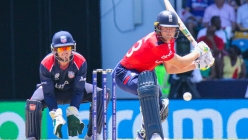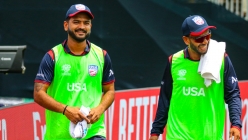USA Cricket: 2019 Super50 Tour Report Card Part 3 – Outlook for UAE ODI Tri-Series
2019 Dec 07 by DreamCricket USA

Photo credit: Peter Della Penna
In Part 3 of DreamCricket's tour review of the 2019 CWI Super50, more analysis is given to Steven Taylor's role in the batting order and the need to have a long-term strategy in place with regards to selecting home grown players.
By Peter Della Penna (Twitter @PeterDellaPenna)
1: Make Steven Taylor open the batting
This is a repeat of a recommendation after the last ODI tri-series in Florida. This time around there is more statistical evidence compiled to support it. Below are a few sets of eye-opening stats related to Taylor that document how he has scored in his 50-over career representing three teams (USA, Jamaica, ICC Americas) as an opener vs. how he has fared batting at No. 3-6.
Steven Taylor overall as an opener
1356 runs in 46 innings
30.82 average
8 50s, 2 100s
96.65 strike rate (1403 balls faced, 159x4, 50x6)
Steven Taylor overall at No. 3-6
862 runs in 39 innings
22.68 average
4 50s, 0 100s
68.25 strike rate (1263 balls faced, 72x4, 25x6)
Taylor averages eight runs less in his career when he’s not opening, scores at a drastically slower strike rate, and has 60% fewer 50-plus scores. Most alarmingly, his boundary rate drops by 54% when he is not opening the batting.
The numbers are just as jarring when analyzing how much time Taylor spends at the crease in his longest innings, highlighting how vital it is for him and the team to be utilizing the entire Powerplay overs. In Taylor’s career, he has been at the crease for 20 overs or longer on 14 occasions: seven as an opener and seven times batting at No. 3. See the disparity between how much more destructive he has been in his career when he has been able to access the entire Powerplay to get set for a lengthy innings at the crease.
Taylor spending 20+ overs at the crease as an opener
675 runs in 7 innings
5 50s, 2 100s
112.50 average
115.38 strike rate (585 balls faced, 66x4, 33x6)
Taylor spending 20+ overs at the crease entering at No. 3
404 runs in 7 innings
4 50s, 0 100s
67.33 average
74.12 strike rate (545 balls, 33x4, 12x6)
In his longest innings when he has been able to access 100% of the Powerplay, Taylor’s average is 45 runs higher, his strike rate is 41 points higher and his boundary rate is once again more than double what it is when he comes in at No. 3 and doesn’t have the same access to attacking with the field up.
In this Super50 tour alone, 12 of USA’s 32 boundary shots in the Powerplay were scored by Taylor despite his limited access to being at the crease in the Powerplay. In the same vein, it represented 12 of Taylor’s 22 boundaries on tour. He is not nearly as effective once the field is pushed back and he becomes especially limited because he is poor at rotating the strike as well. It’s worth highlighting three players to demonstrate their subtle but significant discrepancies in strike rate vs. dot ball percentage.
Strike rate at Super50
73.71 – Monank Patel
68.75 – Karima Gore
65.61 – Steven Taylor
Dot ball percentage at Super50
64.4% - Steven Taylor
53.8% - Monank Patel
50.0% - Karima Gore
Even though Gore’s strike rate is just three points higher than Taylor, he scores off 14% more deliveries. Essentially, if Gore faces every ball in an over, he will score off three of them whereas Taylor will only score off two. And outside of the Powerplay, Taylor’s ability to score is far worse.
There is another way to interpret all of this data. The majority of Taylor’s innings as an opener came from 2010-2017 whereas he has been batting at No. 3 since the start of 2018. A pessimistic approach is to say that Taylor has turned into a very below average batsman in the last two years, which is a far more worrying proposition. An optimistic approach is to say that Taylor is still capable of being destructive but the reason that he has not been destructive in the last two years is because he is batting out of position.
The easiest and best solution for Taylor in the team is for him to open and for Monank to bat at 3. Taylor is more aggressive than Monank in the Powerplay in terms of his boundary striking and Monank is easier to bat with for players in the middle order because he is far better than Taylor at rotating the strike because his dot ball percentage historically has been lower than Taylor and on the Super50 tour alone it was 10.6% lower. Taylor is not designed to bat until the end of the innings like a No. 3 should. Best to maximize his scoring in the Powerplay when it benefits him and the team most rather than waste him at No. 3 in an attempt to idealize him as someone who can anchor an innings. Monank is that anchor player, not Taylor.
2: Float Karima Gore up to No. 5 to accommodate Aaron Jones
The other element that is important to note in the stat bytes above is the extreme efficiency of Gore at rotating the strike. Gore came up through the Leeward Islands U-19 team initially as a middle-order batsman. He has the softest hands on the USA team and is incredibly efficient at rotating the strike and running pedal to the metal between the wickets.
The old school strategy for lineups was to just stick to a predetermined order no matter the situation. But that has been shown to be increasingly outdated in T20 cricket and to a lesser extent in 50-over cricket. Modern strategy dictates that positions in the 4-7 range should be decided based on overs remaining rather than a fixed position. In that vein, it’s important to conceptualize floating batters up or down based on who complements them best in the order.
Aaron Jones’ batting style is based around pinching tight singles ad nauseum with delicate cuts and flicks off his pads. His scoring efficiency has plummeted on USA’s last two tours because the player he thrived most with as a batting partner, Hayden Walsh Jr., is no longer around. Walsh Jr. meshed perfectly with Jones because Walsh Jr. similarly had soft hands and was a maniac at stealing tight singles and hard twos from the non-striker’s end for Jones. Most of the current USA lineup does not have the aggression from the non-striker’s end to support Jones after he enters at No. 4.
From that standpoint, USA management must seriously consider assigning Gore as a standby batsman to come in at No. 5 if the batsman who loses his wicket at that stage is not Jones. Gore is not a boundary striker so having him come in at No. 7/8 as he has been recently is a wasted proposition, especially if he is entering in the 40th over at that stage when boundary striking is essential. If he comes in at No. 5 to join Jones at the 25th/30th over mark, a natural byproduct is for Jones to be far more efficient at pinching ones and twos because that is precisely how Gore bats as well. Nobody is as aggressive from the non-striker’s end as Gore.
Again, there has to be room for flexibility for this strategy. If Jones comes in at No. 4 and winds up being the next wicket to fall, there is no sense to send in Gore at No. 5 to support the remaining batsman at the crease not named Jones. Similarly, if Gore is penciled in at No. 7 and Elmore Hutchinson at No. 8, the normal expectation would be for Hutchinson to be promoted ahead of Gore if the fifth wicket falls with five overs to go and USA is looking for some quick runs in the last 30 balls courtesy of some big sixes from Hutchinson.
But Gore has consistently demonstrated he is capable of filling a role in the middle overs period that few others have delivered on. It’s also worth noting that of USA’s three half-century partnerships during the CWC League Two ODI tri-series in Florida in September, one of them was produced by Jones and Gore when they added 58 together for the seventh wicket to dig USA out of trouble in an eventual five-run win over Papua New Guinea. He is skilled enough to make it a successful strategic ploy.
3: Don’t give up on picking and developing homegrown players
One of the salient storylines that unfolded in Trinidad was the success of Cameron Stevenson throughout the tour and Ian Holland in the final match as USA’s newest additions contrasted with the comparative failure of Jessy Singh and Sagar Patel to impress when they were given opportunities. In ICC events, it is imperative to pick the best eligible XI because of the financial implications at stake so it is hard to fault USA Cricket administrators for continuously scouring the globe for American citizens abroad.
But the reality is that continually relying on players like Hayden Walsh Jr., Aaron Jones, Karima Gore, Stevenson and Holland to make themselves available means that players who come up through USA’s U-19 system will be pushed further back in the queue and consequently will be discouraged to the point of giving up cricket and pursuing other sports and leisure options. Because the Super50 tour was a non-ICC qualification event, it was a perfect opportunity to select some of USA’s recent U-19 players from 2017 and 2019 who are in need of exposure and experience against a higher caliber opponent, but the opportunity went to waste.
It’s worth remembering that Taylor was first brought on tour with the senior team in 2008, touring Guyana as a 15-year-old for the previous incarnation of the West Indies Regional Super50 Cup. It’s remarkable to think that as much as USACA was maligned over the years for many of their administrative missteps, the selectors and administration of that era were at least willing to give opportunities to homegrown players such as Taylor, Akeem Dodson, Muhammad Ghous by the age of 21. The same cannot really be said of USA Cricket because not a single USA U-19 player from 2017 or 2019 has been given a senior cap under the new administration.
By the same token though, guys like Jessy Singh and Sagar Patel have not done much with the opportunities they have gotten. When that happens, it increases the pressure on anyone else who comes through the USA U-19 system after them to do something magical to reverse the ingrained mindset among administrators that locally developed players are not good enough, or at least are not as good as ones developed overseas. In that sense, neither Jessy nor Sagar have done any of the USA U-19 players from 2017 or 2019 any favors.
At some stage though, there has to be an administrative mandate to pick at least one or two recent USA U-19 players in a touring squad. Even if they ride the bench the whole tour, they will learn by osmosis from some of the senior players and it will benefit them in the long run. That’s what happened with Taylor in 2008, who never played a game in that WICB 50-over Cup in Guyana.
It’s also important from a long-term sponsorship and investment standpoint to be picking locally developed players. It is hard to convince local sponsors to invest funds towards local player development if they don’t see any locally developed players in the national team. This is not an ethnic issue either but rather a cultural and grassroots one. California Cricket Academy on the west coast and DreamCricket Academy on the east coast are able to successfully gain sponsors for their various league and touring efforts because the players are predominantly American-born, regardless of their ancestral family heritage.
At the moment, soliciting Fortune 500 sponsors who want to invest in USA Cricket might want their money earmarked for the women’s team instead of the men’s team simply by virtue of the fact that the two most exciting and promising players at the Women’s T20 World Cup Qualifier in Scotland this summer were Geetika Kodali and Lisa Ramjit, a pair of American-born and raised teenagers. Those players simply don’t exist in the USA men’s setup at the moment outside of Taylor. If that selection pipeline is continuously clogged preventing USA U-19 players from graduating into the men’s national team, then the sponsorship and funding pipeline will dry up as well.
ICYMI - Part 1: Team Grades. Part 2: Player Grades.
[Views expressed in this article are those of the author, who was present at all of the team's matches on tour in Trinidad, and do not necessarily represent the views of DreamCricket management. If you have different views or opinions, we respect those views and urge you to provide your feedback, both positive and negative. Feel free to respond to the author via Twitter @PeterDellaPenna.]




